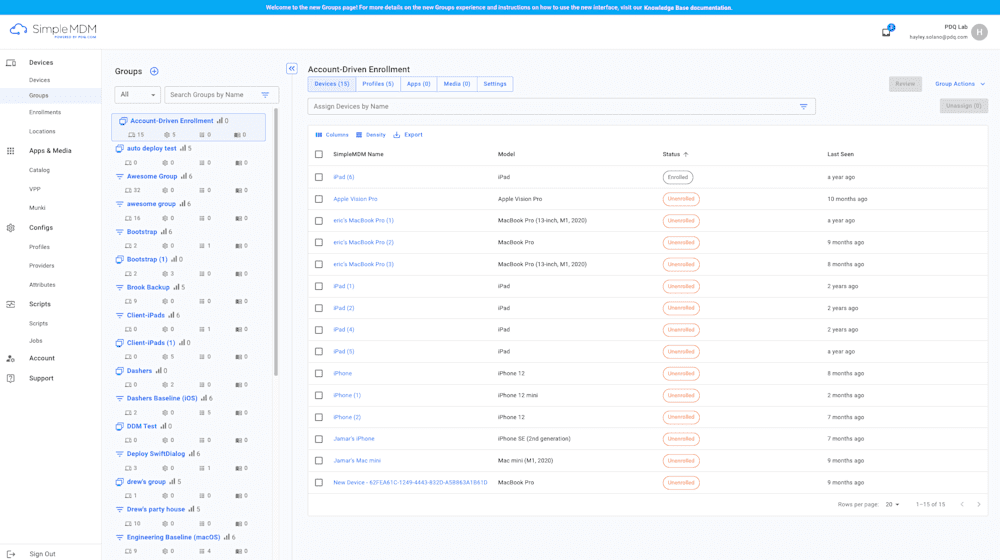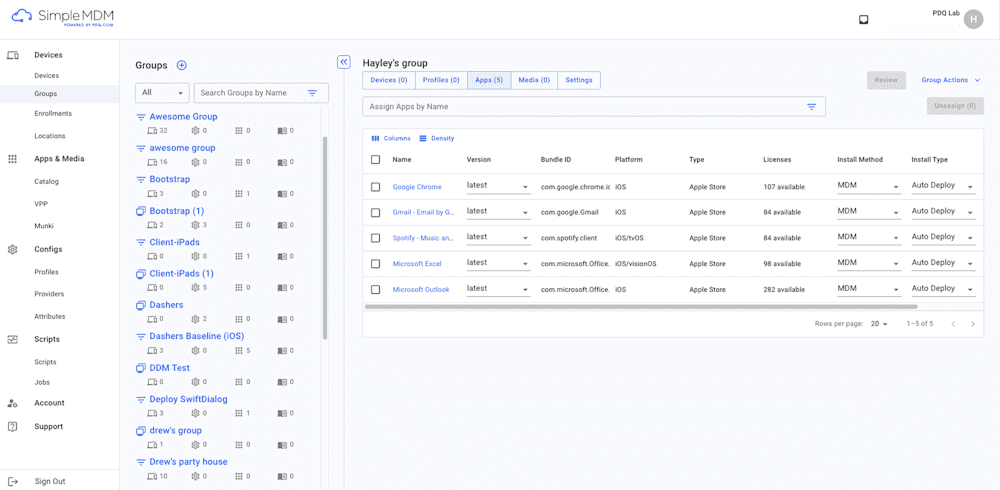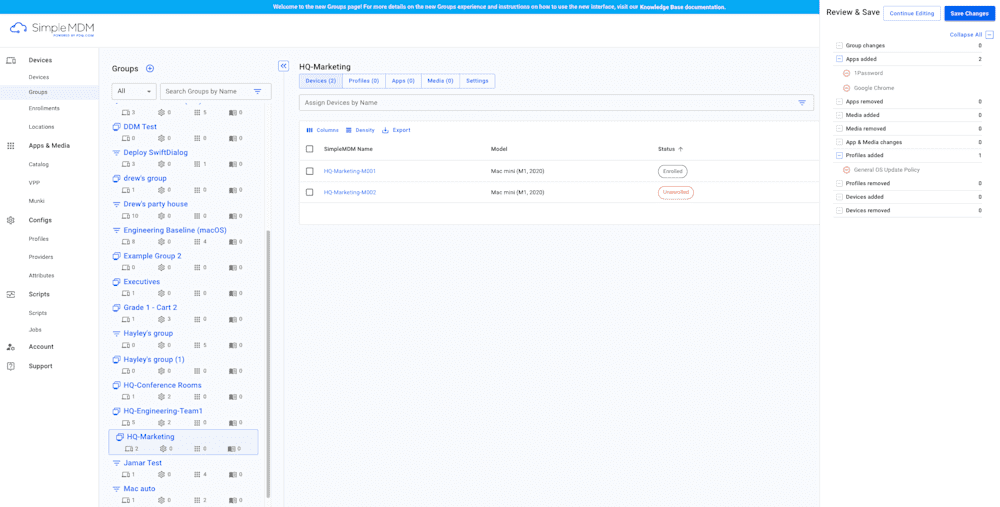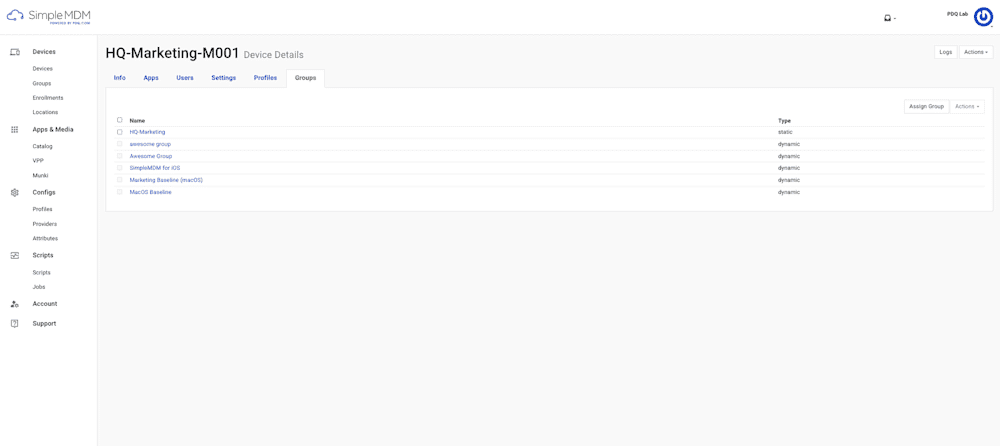Simplify complex workflows and expand your automation capabilities with SimpleMDM’s dynamic groups. This update marks a significant milestone for SimpleMDM, bringing powerful improvements to device grouping and introducing new functionality that makes organizing and managing devices easier than ever.
In this article, we walk you through the new functionality for grouping devices, managing profile and app assignments, and using the simplified interface for managing groups.
Manage your Apple devices — dynamically!
The wait is over — SimpleMDM now supports dynamic groups!
Groups have always been the core mechanism for organizing device inventory, applying configuration profiles, assigning applications and media, and defining custom attribute values. With dynamic groups, you can automatically group devices based on similar criteria through custom filters.
Dynamic groups drastically expand the automation capabilities of SimpleMDM, simplifying even the most complex workflows. Admins can configure custom filters for groups, automatically assigning devices that meet the filter criteria with the necessary apps and configurations. If the device state changes and no longer meets the criteria, it will be automatically unassigned. This allows for quick, logical grouping based on hundreds of criteria, such as model, OS version, passcode compliance status, FileVault encryption status, custom attribute values, static group membership, installed applications, and much more.
Compounding automation
Dynamic groups work seamlessly with other automation options that SimpleMDM supports today.
Scripts & auto attributes
Auto attributes allow admins to run scripts on devices and store the script output as values in custom attribute fields on the device record, automating the collection of custom information from devices. With dynamic groups, you can now filter based on these custom attribute values, allowing devices to be grouped automatically based on the information collected.
Enrollment authentication
SimpleMDM supports SAML authentication for device enrollments. In addition to providing an extra layer of security for company-owned devices, user data from identity providers can be automatically collected and stored in custom attributes. Paired with dynamic groups, this makes it easy to group devices based on identity provider data, such as role, department, location, region, and more, ensuring devices receive the appropriate configurations and applications.
Multigroup membership
Another new feature is the ability to assign devices to multiple groups. Previously, devices could only belong to one group at a time. With multigroup membership, admins can now segment devices into groups that better match their organizational structures. This reduces the need to create nearly redundant groups to accommodate slight configuration differences.
Configuration conflict resolution
Now that devices can belong to multiple groups, there is a potential for configuration conflicts. For example, some profile types, like App Restrictions, only allow one profile per device. If a device is a member of two groups with different App Restrictions profiles assigned, this could create a conflict. To solve for this, SimpleMDM allows admins to set priority levels for each group. Profiles assigned to groups with a higher priority level will “win” if there is a conflict with another profile of the same type assigned via a lower priority group.
Refreshed Groups interface
SimpleMDM is introducing a completely new interface for managing groups. Built on a modern, user-friendly framework, the new Groups page puts all group and configuration assignments into a single view. In the old interface, groups, profiles, and app assignments were spread across several pages. The new design makes it easier to get a comprehensive overview of all the groups and update assignments without navigating away.

One group, all app types
Previously, apps were assigned through separate app assignment groups, distinct from device groups, which were primarily used for assigning profiles. Admins had to create different app assignment groups for various app install methods (MDM vs. Munki) and install types (managed, self-serve, etc.). With this update, all app types and install methods can now be assigned to the same group. Like multigroup membership, this change makes it easier to align groups with your organizational structure and reduces the need for multiple groups to achieve the desired setup.

Review & Save panel
The new Review & Save panel allows you to quickly review all changes to your groups, remove any undesired updates, and save. This helps prevent unintended configuration changes from being pushed to devices and optimizes the deployment process, potentially resulting in faster changes.

Groups tab added to Device, App, and Profile Details
We added a new Groups tab across several key detail pages in the UI, allowing admins to view and manage group assignments for individual devices, apps, and profiles. From this tab, admins can see all groups a device, app, or profile belongs to, along with the group type (static or dynamic). Admins can also manage static group assignments, including assigning or unassigning devices from static groups.

Granular user roles for groups
This update also brings more granular options for user roles relative to groups. Now, admins can create custom permission sets for other users in their accounts that control access to groups as whole, as well as grant/revoke access to group assignments for specific objects (devices, profiles, apps, media, and group settings).
New app assignment options
The new Groups UI also introduces some new options for managing app deployments. Most notably:
Admins can mark App Store apps as unremovable so that users cannot uninstall them. This option can be found in the Removable column under the Apps tab for Groups with App Store apps assigned.
Admins can specify the automatic app update interval on a per-app assignment basis. Previously, this setting was only available globally for all apps. This granular control is useful when admins want some apps to be checked for updates more frequently than others or if they want to prevent automatic updates for specific apps but automatically update others.
This feature-packed update is now available to all accounts. If you’d like to give SimpleMDM a try, sign up for a free 30-day trial.

